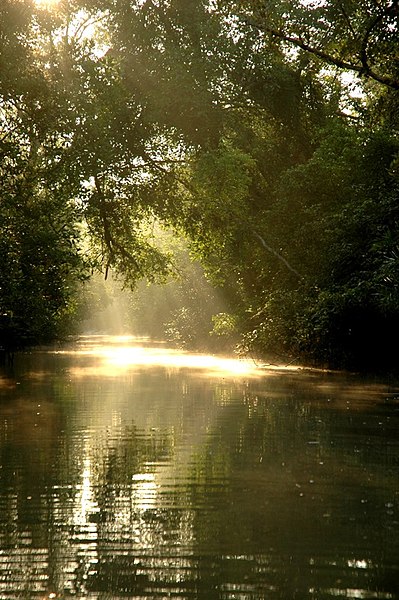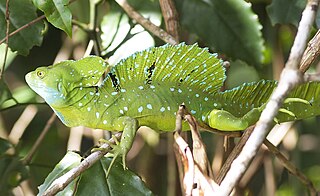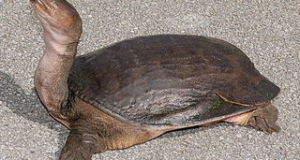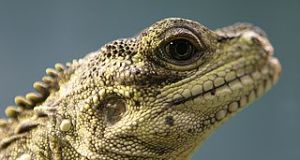The three species in the genus Hydrosaurus, commonly referred to as Sailfin Dragons, are among the most spectacular lizards on earth. Even after decades of working with all manner of reptiles in zoos and the field, I’m still stopped in my tracks by the sight of one. Unfortunately, the coastal swamps and forests they inhabit are being developed out of existence, and captive breeding is not common. Recently, genetic studies of lizards illegally held in Philippine pet markets surprised herpetologists by bringing to light a new species of Sailfin Lizard.
The Currently-Recognized Species of Sailfin Dragons
The Philippine Sailfin Lizard, Hydrosaurus pustulatus, is the species most commonly seen in the pet trade. Stoutly built and reaching over 3 feet in length, males sport huge crests along the back and tail, and are clad in several shades of green, neon purple, and red-tinted blue. Small wonder they are high on the wish-lists of lizard enthusiasts worldwide (and “large wonder”, in my opinion, why zoos do not pay them more heed!).
The Amboina Sailfin, H. amboinensis, is found in Indonesia and New Guinea; its occurrence in the Philippines is debated. Weber’s Sailfin Lizard, H. weberi, appears limited to the Indonesian islands of Ternate and Halmahera.
Unfortunately, Sailfin Lizards are a poor choice for all but experienced keepers with a great deal of space. They require huge enclosures and usually remain high-strung, even after years in captivity. Today, as in years past, nearly all in the trade are wild-caught, and captive breeding is very rare.
An Uncertain Future for Sailfin Lizards
In order to access the Sailfin Lizards’ status and formulate a conservation strategy, herpetologists from the University of Oklahoma surveyed natural habitats and pet markets in the Philippines (Biological Conservation, V 169, Jan, 2014). The coastal marshes and riverside forests upon which these lizards depend were found to be under immense pressure from logging, fishery expansion and other forms of development. Only 10% of the Philippine Sailfin Lizard’s habitat lies in protected areas – the rest is open to human activities. The species is classified as Vulnerable by the IUCN.
Illegal collection also seems to be a problem, as black market animals were easy to locate, and field surveys of easily-accessible habitats revealed few adult specimens.
A New Species Emerges
Animal markets in Manila seem to be the main source of entry into the pet trade. DNA studies of scale and nail-clippings from lizards found in these markets revealed that Sailfins inhabiting Sulawesi, Indonesia are genetically distinct from those in New Guinea; both are now classified as H. pustulatus. The newly-described species has not yet been named.
Why Bother with Genetic Identification?
“Discovering” new species via genetic research is becoming ever more common, and I think there’s sometimes a tendency to regard this as less noteworthy than finding an animal that is “new” in the sense of having never been seen, or seen only by people living within its habitat.
However, it’s important to bear in mind that genetic differences evolved over millions of years undoubtedly have survival value. Well-known examples abound – Green Anoles from southern Florida cannot tolerate north Florida winters, venoms of rattlesnakes with wide ranges differ radically (in response to prey defenses) from place to place, and so on. These unnoticed but very significant differences can greatly affect conservation plans and captive breeding attempts.
Also, properly identifying a species can have important implications where legal protection is concerned. Considering the horrific confusion and red tape that plagues international conservation laws, any means of introducing order and clarity should be welcomed.
A Sailfin Dragon “Substitute” for Lizard Fans
As mentioned earlier, Sailfin Lizard ownership should not be undertaken lightly, as they are quite demanding pets. However, those who are enamored of large, beautifully-colored lizards bearing “dragon-like” crests do have excellent alternatives – the Green Basilisk, Basiliscus plumifrons and the Asian Water Dragon, Physignathus cocincinus. You can read more about the care and breeding of these very impressive lizards in the articles linked below.
Further Reading
 That Reptile Blog – Reptile, Amphibian and Exotic Pet Care and Information
That Reptile Blog – Reptile, Amphibian and Exotic Pet Care and Information







The lizard depicted in the second photo is actually a male plumed basilisk (Basiliscus plumifrons), not a sailfin lizard (Hydrosaurus sp.).
Hello,
Yes indeed…sorry if not clear, but please see the paragraph next to the photo. best, Frank
Thanks for your reply. However, then why still use the description “A Sailfin Dragon” next to it?
And as for the two species mentioned as alternative pets: both also have husbandry requirements the average reptile keepers(and a bunch of zoos) usually fail to meet in an adequate way. Therefore, I wouldn’t call them “excellent alternatives”, but other examples of lizards with high husbandry demands, more commonly encountered within the exotic pet community.
Sorry for being a wisenheimer, but I’ve seen my share of lizards crippled, sickened and killed due to bad husbandry and I’ve thus become a bit more critical about the abilities of people being capable of keeping lizards…
Hello,
Thanks for your thoughts; As all lizards have specific needs that must be met if they are to thrive, I referred readers who are interested in water dragons or basilisks to articles that address their care.
Best, Frank
Good day, sir. My sailfin lizard wont eat its meal, what can be the cause of this and what should I do to bring back his (its a male) appetite? Thank you, sir and have a good day.
Hello,
There can be a great many reasons…please send some info on animal’s history, diet, temperatures, UVB exposure, cage size etc. Thanks, best, Frank
I gave him mealworms and bananas. Honestly, I dont measure the temperature, but I think its about 29-32 degrees centigrade. Right now he is still on my 10 gallon tank because Im still preparing my 25 gallon tank. He is just 18 inches long. As for the UVB exposure, I let him out in the sun during mornings for about half an hour.
Sorry, I know that I am not giving my sailfin enough, but I am trying to give him the best. I love him and I am really worried. Thanks for your help, sir. Have a nice day.
Milmer
Hello,
Unfortunately it will not live long under those conditions…they need a highly varied diet, including whole fishes…mealworms and bananas are of little nutritional value to them. basking site should be at 30-32 C, with cooler areas available..you’ll need a larger tank in order to establish different areas of cool/hot temps. 1/2 hour of sun is not likely enough…glass filters out UVB, so exposure should be direct, or via UVB bulb. They can be kept as described for water dragons in this article. Please let me know if you need more info, frank
Okay, thank you so much for your help!
My pleasure, let me know if you need anything, best, Frank
Hi! Love sailfin dragons! Bought a hybrid from a reputable breeder here in the USA in early 2013. He was about 10inches nose to tip of tail. He’s now 30+ with beautiful blue coloration with an impressive sail for a 2year year old. as mentioned in the above article they are very timid for a while. For the first 6 months or so the only “together time” we spent was me reaching in and working around his enclosure while he watched. After some time of this I began offering mealworms from my hand instead of his dish and he happily devoured them. Now after two years of good old slow progress, as soon as I open the door, he comes running over and up my arm to his spot on my shoulders where he eats and observers his surroundings from. Sometimes when he wants to come out he will sit behind my chair in his enclosure and “head bob” at me to get my attention. He’s like a scaly cold blooded dog lol. He also has no problem going in a iguana harness and going for rides in the car to local pet shops. Over all I have to say he has a huge personality and knows us well. Does not mind strangers in public but dosnt like seeing strangers in our home. A must have for all sailfins is space, heat, good daylight lighting, various food items, humidity and a large flowing filtered water supply as this is where they typical go the bathroom. BUY CB BABIES ONLY!
Hello Nick,
Thanks very much for the feedback and congrats on your success. Enjoy and please keep me posted, Frank
Thanks Frank! Really enjoyed your article! Will keep you posted. May try a breeding project in next couple years if I can get my hands on a ambo female!
Thanks for the kind words, Nick. We definitely need more interest in breeding..are they hard to come by where you are? Best, frank
Yes they are! I live in upstate ny. About 2 1/2 hours outside the city. I purchased mine from a experienced breeder in Florida. He is very good and happily answers any questions. Sailfindragon.com Scott is highly experienced in sailfin care and breeding. Will have to come visit the Bronx zoo. Live so close and have never been.
Good to get from exper private breeder; I’ll forward folks looking for one to him, thanks. I’ve retired from the zoo, still do freelance work but am not usually on site. My old contacts are all moving on, but yes, worth a visit, reptile collection looked good last time I was there, young Komodo dragons now exhibited in elephant house (w/o elephants!). Best, Frank